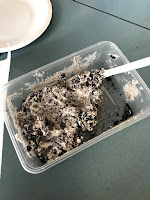
Our session began with Alex and I giving Jannie an overview of what our intention is with the collaboration between Social Studies and DigiTech with the Human Rights Project, and our ideas around using the collaboration as a platform to accelerate achievement around writing for the students.
Originally I'd thought of using AsTTLe writing data to measure progress before and after the unit of work. However, through our discussions, Jannie emphasized the benefit of diving deep into broadening content knowledge and understanding for the students, and then focusing around what has been learnt by investigating a range of perspectives.

Within DigiTech I can still have the students develop a timeline of events that has lead to the current situation at Ihumātao, and for the students to develop this into an animated slide deck. The slide deck can include a range of perspectives; some of which can go into depth and detail, using content taught in both Social Studies and DigiTech. Hopefully Alex and I can go into more depth across both of our subjects by selecting a couple of perspectives each to delve into with the students. Still thinking of ways for the students to capture this. At this stage, I'm thinking more around the opportunities that we provide the students with to inquire into the different perspectives. The biggest obstacle is actually class time, as I see the students 3 x lessons per week, and we've got approximately 4-5 weeks left in this semester.
A basic pre-assessment and post-assessment of knowledge and understanding about Ihumātao will hopefully give a strong enough indication of a shift for the students. So, next steps forward is to undertake a pre-assessment exercise with the students. Also, for Alex and I to decide on the perspectives that we'd like the students to inquire into, and the approach we will take with the students. This will probably be the focus of our next meeting.

















































